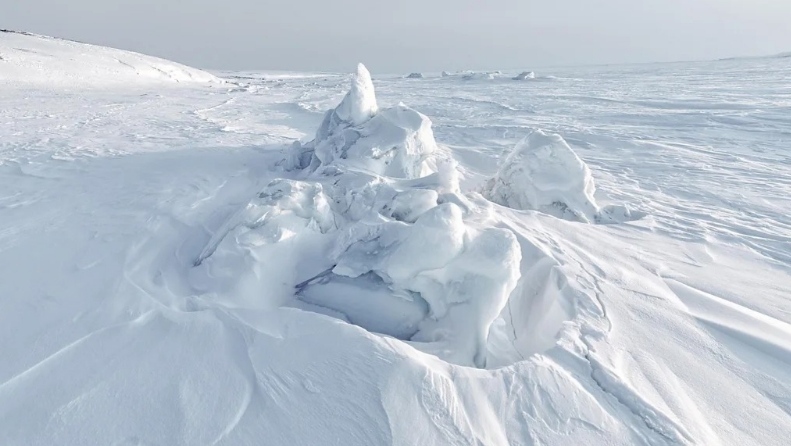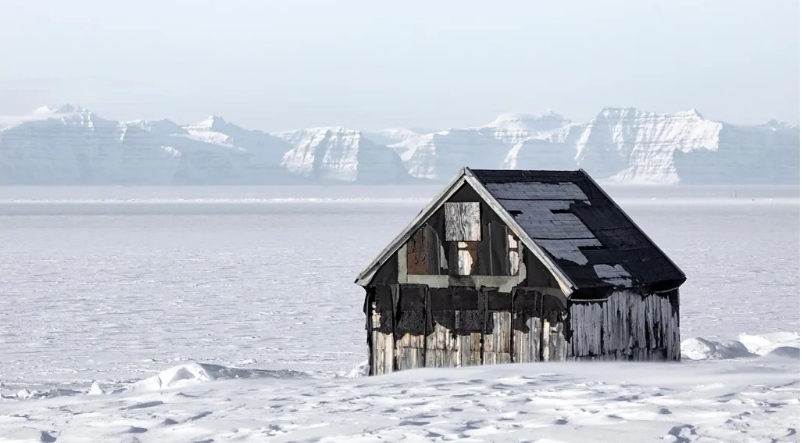Photographing one of the most remote places on Earth

Frozen in for nine months every year and located 800km from the next town, Ittoqqortoormiit, Greenland, offers a fascinating glimpse at life at the edge of the world.
In our ever-connected world, it’s rare to experience true remoteness. It’s also extraordinary to witness how people live in one of the Earth’s most isolated places. But earlier this year during a once-in-a-lifetime photographic expedition to the most remote inhabited community in the western hemisphere, I was able to do both these things.
Ittoqqortoormiit (pronounced: it-ockor-tormit) is a 370-person village of colourfully painted homes sandwiched between the world’s largest national park to the north and the largest fjord system in the world to the south. There are no roads to Ittoqqortoormiit; the only way to get there is by helicopter, boat (in the summer), snowmobile or one of two weekly flights to Nerlerit Inaat airport, roughly 40km away: one from Iceland, and the other from West Greenland.
Located above the Arctic Circle at 70°N and roughly 800km from the nearest town, Ittoqqortoormiit’s backyard is a frigid, untamed wilderness home to polar bears, musk oxen and millions of sea birds who nest on icebergs. Sea ice freezes the village in for nine months a year, but offers a lifeline to Ittoqqortoormiit’s Inuit inhabitants, who travel it by dog sled to hunt. The village will celebrate its centenary in 2025, but in recent years, its population has been shrinking (35% since 2006, by some estimates) as young people are increasingly migrating to cities to study or pursue different careers than the traditional Arctic hunting of their forefathers. What’s more, as rising temperatures cause the surrounding sea ice to freeze later and melt earlier, Ittoqqortoormiit finds itself on the front lines of climate change, which is further threatening the Indigenous community’s culture.
My winter excursion to Ittoqqortoormiit wasn’t just an adventure that took me outside my comfort zone; it was one of the most challenging experiences I’ve ever had. After flying from Reykjavík to Nerlerit Inaat, I spent five days on the pack ice in temperatures plummeting as low as -40C. I travelled on dogsleds, slept in tents and small hunter huts (with no beds, running water, heating or facilities) and dashed 45km on a snowmobile through a white-out blizzard with 80kmph winds.
Ultimately, this turned out to be far more than a photography expedition, as it offered a rare glimpse of life in one of the most remote landscapes on Earth. It also revealed how Ittoqqortoormiit’s remaining residents are struggling to adapt their deep-rooted traditions to a rapidly changing world.

Baptism by cold
My trip was organised by the renowned photographer Joshua Holko, who arranged for two local Inuit guides, Åge Danielsen and Manasse Tuko, to whisk myself and two other photographers across the ice on their dog sleds from the Nerlerit Inaat airport to Ittoqqortoormiit with the aim of capturing some of Earth’s most stark, stunning polar landscapes.
We established camp in small tents close to the airport the first night as temperatures were -30°C and falling. After sawing frozen cod on the snow, as a carpenter would cut through timber, and boiling it in a pan of melted ice, Danielsen and Tuko announced that dinner was ready. The cod was excellent, if bony, but we were more concerned about what lay ahead. I had never experienced cold like this before, and as we hunkered down for the night, strong winds battered the tents while the sled dogs howled when Arctic foxes and – perhaps – polar bears passed. As the temperature continued dropping, my legs soon started to cramp. It was truly a baptism by cold.

National icons
Shortly after breakfast, Danielsen and Tuko started loading our supplies. As I watched, they expertly transformed the empty dog sleds into containers on skates filled with bags, cooler boxes, camera cases, dog food and more. They skillfully tied the goods on with ropes, demonstrating skills that they explained were passed down from father to son.
We sat two to a sled with a guide at the front driving the dogs. For the next six days, 12 Greenland sled dogs assigned to each sled carried loads of more than 450kg and ran their hearts out for up to 25km a day. These beloved animals (called qimmiit in Greenland’s Inuit language, Kalaallisut), which are a large husky-type breed, are believed to have been brought from Siberia to Greenland some 1,000 years ago by the Inuit’s direct ancestors, the Thule people, and are something of a national icon in Greenland. Not only do they represent an important part of Inuit culture and their connection to the land, but as we’d soon find, they also had the advantage of being much quieter than snowmobiles, therefore improving our chances of photographing wildlife – or, in Danielsen and Tuko’s case, when they weren’t guiding us, hunting wildlife.

Prehistoric beasts
One morning, after eating toast heated by spearing it with a knife and holding it over a burner, Danielsen pointed up towards the mountains as the dogs carried us 10km west of Ittoqqortoormiit. We looked up and saw four musk oxen standing on a distant ridge.
Weighing up to 400kg, these prehistoric-looking beasts, with short horns protruding from their cheeks and long-flowing black and tan fur overcoats blowing in the strong wind, were as photogenic as they were imposing. We disembarked from the sleds and proceeded with great caution, as Holko warned us that these Ice Age relics can be skittish and aggressive: move too quickly and they will run off; get too close and they will charge. After an hour of shooting these goliaths, they started climbing higher into the mountain passes, perhaps knowing that they are regarded as a local delicacy in Ittoqqortoormiit.

The hunter
On our third day, Danielsen mentioned that he owned a hut about 25km away and invited us to spend two nights there. We were humbled by his kindness – especially because his home was strategically positioned to spot polar bears on the pack ice. The brightly painted blue hut was just large enough for a small sofa, chair, sink, stove and a rare sit-down toilet – but the most noticeable feature was the large slaughter hook hanging from the ceiling.
It reminded us that whilst Danielsen may have taken on guiding to supplement his income, hunting is his passion, his profession and his ancestral tradition. By law, hunters here aren’t allowed to sell meat or skins from their kills – or in the case of musk ox, import them abroad. Instead, the meat can only be used to provide food and clothing for families – just as it has for generations.

A family tradition
While at his house, we learned that Danielsen wasn’t just a proud Inuit hunter but also a father of four children. He explained that his father was a hunter, his grandfather was a hunter and he hoped his youngest son would follow in his footsteps one day. Holko had found a skull of a musk ox the previous day and gave it to Danielsen, who was elated. I asked Danielsen if I could photograph him holding the skull and he happily obliged.
Later over dinner, we talked. “Look at these photos,” Danielsen said smiling, as he showed me his mobile phone. “This is my father, yesterday.” His father was standing over a huge polar bear lying dead on the ice. “And look at these,” he said with great pride, swiping through photos of three huge adult polar bears that he had killed. Due to warming temperatures over recent decades, polar bears have been forced to change their migration patterns, bringing them closer to communities like Ittoqqortoormiit and posing real dangers to people and themselves.

Nature’s ice sculptures
From Danielsen’s hut, we headed 20km east. As our sleds glided over the snow and ice, I marvelled at the scenery and serenity that surrounded me.
The light was magical; misty and moody with soft rays of sun caressing the blue-toned pack ice. We passed towering icebergs and eruptions of compacted ice that nature had sculpted into works of art. This was a landscape photographer’s paradise. Being in complete darkness at night with no light pollution, the Northern Lights regularly dance through the skies on clear nights in autumn and winter. Even this phenomenon, known locally as arsarnerit (“those who play ball”) has a connection to hunting, as the lights are believed to be the souls of children playing with a walrus skull.

The “ghosts of the Arctic”
After five long days of travel, we arrived at Kap Hope, a small settlement of about 20 old huts 14km west of Ittoqqortoormiit with views of ice pack for miles. Exhausted and bitterly cold, the six of us unfurled sleeping bags in one of the cabins. The following morning, as he peered out of a small window with binoculars, Danielsen suddenly shouted, “Polar bear! Polar bear!” and pointed into the distance.
My adrenaline was pumping as I thought about photographing the largest land-based carnivore on Earth – an apex predator that can smell its prey 32km away. We made our way down the side of the mountain, carefully carrying our cameras and longest lenses in heavy winter gear. The bear, 6km away, remained on the ice for 20 minutes or so before sauntering away. I had dreamed about photographing what Holko describes as the “ghosts of the Arctic” – polar bears whose white fur blends in so perfectly with its surroundings that they’re barely visible – but this was the closest I’d come.

Ittoqqortoormiit
There is only one guesthouse in the western hemisphere’s most remote community, and it’s fittingly named Guesthouse. We were due to rest here for the next three days before flying out, and after nearly a week in the frozen wilderness, it took some time to get used to Ittoqqortoormiit. Brightly painted houses standing in deep white snow dominated the landscapes. Teams of dogs were chained to empty sleds like an Arctic taxi rank. Snowmobiles zipped around town as people went about their daily lives.
In recent years, Ittoqqortoormiit has been billing itself as a destination for adventurers – a place where you can cut through the ice on a boat, trek through the tundra, view icebergs and explore a part of the world that few people on the planet will ever see. But as a policeman (one of three, I was told) waved to me as he passed on his snowmobile, I no longer felt like an adventurer, but a small part of this far-flung community.

Life at the end of the world
You can walk across Ittoqqortoormiit in about 30 minutes. It’s comprised of a church, a small travel agency, a police station, a bar, a guesthouse, a heliport and a small supermarket called Pilersuisoq that’s supplied by two ship deliveries each season. Wandering the sparsely stocked aisles, I was struck by the high cost of everything. I wondered how, in a place where there were few jobs, locals could afford these prices.
Outside, the polar bear skins hanging on scaffolding near so many houses reminded me of this community’s origins. I’d embarked on this adventure to capture unique images of wildlife. And while the “ghosts of the Arctic” eluded me on this occasion, it didn’t matter, as I’d gained a far greater appreciation for how people managed to live in one of the remotest places on Earth.
Kevin Hall is a photographer based in England.




